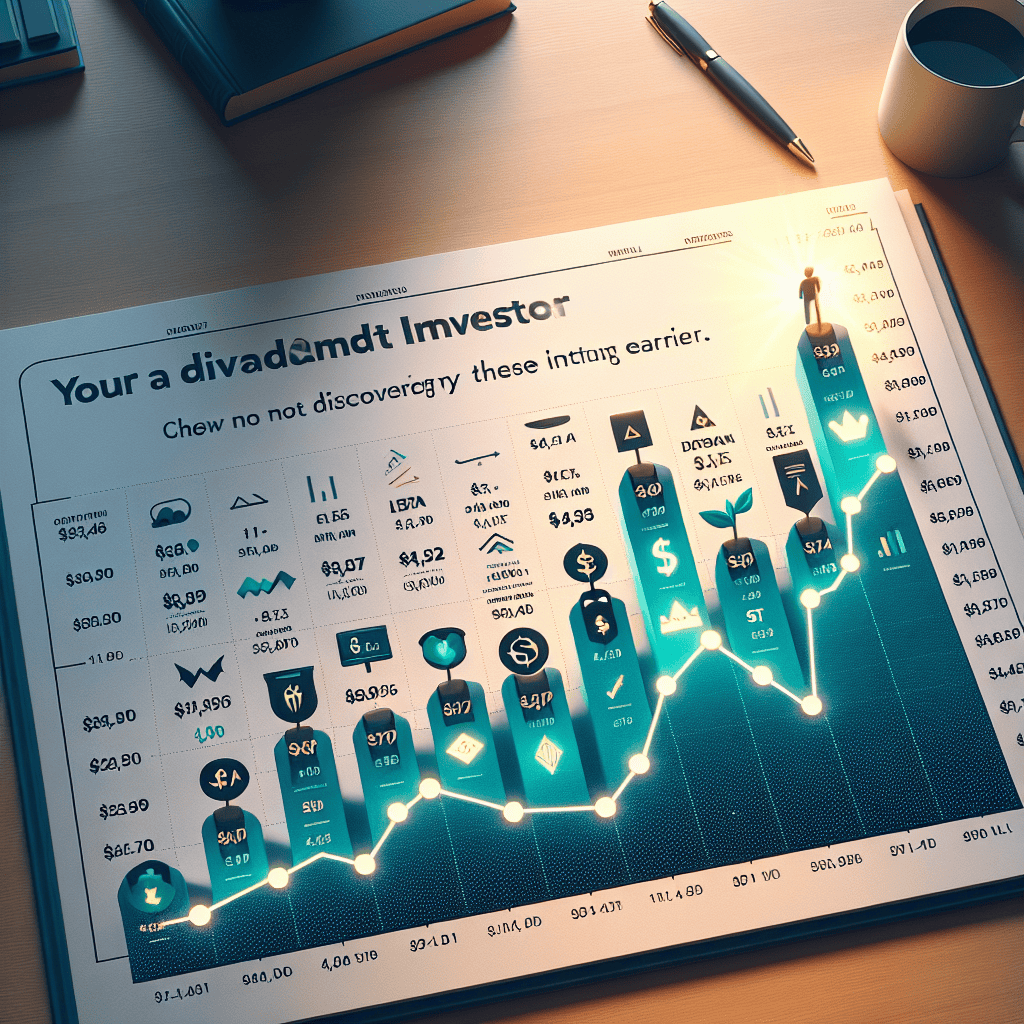“Unlock $9,495 Monthly: 10 Game-Changing Stock and ETF Picks for Dividend Success!”
Introduction
In the world of investing, the allure of consistent, substantial monthly earnings is a goal many aspire to achieve. For one dividend investor, this aspiration has become a reality, with a remarkable $9,495 in monthly earnings. This impressive income stream is the result of a carefully curated selection of 10 stocks and ETFs, each chosen for their robust dividend yields and growth potential. Reflecting on his journey, the investor wishes he had discovered these lucrative picks sooner, as they have significantly bolstered his financial portfolio and provided a steady, reliable source of income. This introduction delves into the strategic choices and insights that led to this enviable financial milestone, offering valuable lessons for both novice and seasoned investors alike.
Understanding Dividend Investing: A Path to Consistent Monthly Earnings
Dividend investing is a strategy that has long been favored by those seeking a steady stream of income from their investments. This approach involves purchasing stocks or exchange-traded funds (ETFs) that pay regular dividends, which are portions of a company’s earnings distributed to shareholders. For many investors, the allure of dividend investing lies in its potential to provide consistent monthly earnings, a goal that can be achieved through careful selection of dividend-paying stocks and ETFs. One investor, who now earns $9,495 monthly from his dividend portfolio, reflects on the ten stock and ETF picks he wishes he had discovered sooner, underscoring the importance of strategic selection in dividend investing.
To begin with, understanding the fundamentals of dividend investing is crucial. Dividends are typically paid by established companies with a history of profitability and stable cash flows. These companies often operate in mature industries where growth opportunities are limited, prompting them to return excess cash to shareholders. Consequently, dividend-paying stocks are often perceived as less volatile and more reliable than their non-dividend-paying counterparts. This reliability is particularly appealing to investors seeking to supplement their income or fund their retirement.
Moreover, the investor’s journey to earning $9,495 monthly highlights the significance of diversification in a dividend portfolio. By spreading investments across various sectors and industries, investors can mitigate risks associated with economic downturns or sector-specific challenges. For instance, while utility companies are known for their stable dividends, they may be adversely affected by regulatory changes. Conversely, technology companies, though traditionally less associated with dividends, have increasingly begun to offer attractive yields as they mature. Thus, a well-diversified portfolio can balance these risks and enhance overall returns.
In addition to diversification, the investor emphasizes the importance of selecting stocks and ETFs with a strong track record of dividend growth. Companies that consistently increase their dividends demonstrate financial health and a commitment to returning value to shareholders. This growth not only boosts income over time but also helps protect against inflation, ensuring that the purchasing power of dividend income is maintained. Furthermore, reinvesting dividends through a dividend reinvestment plan (DRIP) can compound returns, as additional shares purchased with dividends generate their own dividends, creating a snowball effect.
Transitioning to the practical aspects of building a dividend portfolio, the investor notes that thorough research and due diligence are paramount. Evaluating a company’s financial statements, payout ratios, and dividend history can provide insights into its ability to sustain and grow dividends. Additionally, considering the tax implications of dividend income is essential, as different jurisdictions may tax dividends at varying rates. Consulting with a financial advisor or tax professional can help navigate these complexities and optimize the portfolio for tax efficiency.
In conclusion, dividend investing offers a viable path to consistent monthly earnings, as evidenced by the investor’s $9,495 monthly income. By focusing on diversification, dividend growth, and thorough research, investors can build a robust portfolio that not only provides regular income but also appreciates in value over time. While the investor reflects on the ten stock and ETF picks he wishes he had discovered sooner, his experience serves as a testament to the potential of dividend investing as a strategy for financial stability and growth.
Top 5 High-Yield Dividend Stocks for Reliable Income
In the realm of dividend investing, the allure of a steady income stream is undeniable. For many investors, the goal is to build a portfolio that not only appreciates in value but also generates reliable income. This is particularly true for those who have discovered the power of high-yield dividend stocks. One such investor, who now enjoys a monthly income of $9,495, reflects on the ten stock and ETF picks he wishes he had discovered earlier in his investment journey. Among these, five high-yield dividend stocks stand out for their ability to provide consistent and reliable income.
To begin with, the first stock that has proven to be a cornerstone of this investor’s portfolio is a well-established utility company. Known for its stability and resilience, this company has a long history of paying dividends, even during economic downturns. Its regulated business model ensures a steady cash flow, which translates into reliable dividend payments. This makes it an attractive option for those seeking income stability.
Transitioning to the second pick, a leading telecommunications firm, the investor highlights its robust dividend yield. Telecommunications companies often benefit from recurring revenue streams, as consumers and businesses alike rely on their services. This particular firm has capitalized on the growing demand for connectivity, allowing it to maintain a healthy dividend payout ratio. As a result, it has become a favored choice for income-focused investors.
Moving on, the third stock in this high-yield lineup is a major player in the real estate investment trust (REIT) sector. REITs are known for their ability to generate income through property ownership and management. This company, with its diversified portfolio of commercial properties, has consistently delivered strong dividend returns. Its strategic acquisitions and effective management have ensured a steady flow of rental income, which is then distributed to shareholders in the form of dividends.
Furthermore, the fourth stock that has contributed to this investor’s impressive monthly earnings is a prominent energy company. The energy sector, despite its inherent volatility, offers opportunities for substantial dividend yields. This particular company has managed to navigate market fluctuations by focusing on sustainable energy sources and efficient operations. Its commitment to maintaining a strong balance sheet has enabled it to continue rewarding shareholders with attractive dividends.
Finally, the fifth high-yield stock is a consumer staples giant. Companies in this sector are often seen as safe havens during economic uncertainty, as they provide essential goods that remain in demand regardless of economic conditions. This company’s strong brand portfolio and global reach have allowed it to generate consistent cash flow, supporting its ability to pay dividends. Its track record of dividend growth further enhances its appeal to income-seeking investors.
In conclusion, these five high-yield dividend stocks have played a pivotal role in the investor’s journey to achieving a substantial monthly income. By focusing on companies with stable business models, strong cash flows, and a commitment to returning value to shareholders, he has built a portfolio that not only meets his income needs but also offers potential for capital appreciation. As he reflects on his investment choices, he wishes he had discovered these opportunities sooner, underscoring the importance of thorough research and strategic selection in the pursuit of reliable dividend income.
ETFs vs. Individual Stocks: Which is Better for Dividend Growth?
When considering the pursuit of dividend growth, investors often find themselves at a crossroads: should they invest in individual stocks or exchange-traded funds (ETFs)? Each option presents its own set of advantages and challenges, and understanding these can significantly impact one’s investment strategy. Individual stocks offer the potential for higher returns, as investors can handpick companies with strong dividend histories and promising growth prospects. By selecting stocks with a track record of increasing dividends, investors can potentially achieve substantial income growth over time. However, this approach requires diligent research and a keen understanding of market dynamics, as the performance of individual stocks can be volatile and subject to company-specific risks.
On the other hand, ETFs provide a diversified approach to dividend investing. By pooling together a collection of dividend-paying stocks, ETFs offer investors exposure to a broad range of companies and sectors. This diversification can mitigate the risks associated with investing in individual stocks, as the performance of one company is less likely to significantly impact the overall portfolio. Moreover, ETFs are managed by professionals who continuously monitor and adjust the fund’s holdings to align with its investment objectives. This can be particularly appealing to investors who prefer a more hands-off approach or lack the time and expertise to manage a portfolio of individual stocks.
Despite these advantages, ETFs also have their limitations. The diversification that ETFs offer can sometimes dilute the potential for high returns, as the performance of well-performing stocks may be offset by underperforming ones within the fund. Additionally, ETFs come with management fees, which can eat into the overall returns, especially over the long term. Therefore, investors must weigh the benefits of diversification against the potential for higher returns when considering ETFs for dividend growth.
In light of these considerations, some investors opt for a hybrid approach, combining both individual stocks and ETFs in their portfolios. This strategy allows them to capitalize on the strengths of each investment type while mitigating their respective weaknesses. For instance, an investor might choose to invest in a few high-conviction individual stocks with strong dividend growth potential, complemented by a selection of ETFs that provide broader market exposure and stability. This balanced approach can offer the best of both worlds, providing opportunities for significant income growth while maintaining a level of diversification that reduces risk.
Ultimately, the decision between investing in individual stocks or ETFs for dividend growth depends on an investor’s risk tolerance, investment goals, and level of expertise. Those who are comfortable with conducting thorough research and managing a concentrated portfolio may find individual stocks more rewarding. Conversely, investors seeking a more diversified and professionally managed option may prefer ETFs. Regardless of the chosen path, the key to successful dividend investing lies in a well-thought-out strategy that aligns with one’s financial objectives and risk appetite.
In conclusion, both individual stocks and ETFs have their merits and drawbacks when it comes to dividend growth. By carefully considering the unique attributes of each and possibly integrating both into a cohesive investment strategy, investors can position themselves to achieve their desired income goals. As with any investment decision, thorough research and a clear understanding of one’s financial situation are essential to making informed choices that can lead to long-term success.
The Power of Reinvestment: How to Maximize Your Dividend Earnings

Reinvesting dividends is a powerful strategy that can significantly enhance an investor’s portfolio over time. By reinvesting dividends, investors can take advantage of compound interest, which Albert Einstein famously referred to as the “eighth wonder of the world.” This approach allows investors to purchase additional shares of stock or units of an exchange-traded fund (ETF) without having to contribute additional capital. As a result, the investor’s holdings grow at an accelerated rate, leading to potentially substantial increases in both income and portfolio value.
To illustrate the power of reinvestment, consider the case of a dividend investor who earns $9,495 monthly from a carefully curated selection of stocks and ETFs. This investor’s success is not merely a result of choosing high-yield investments but also a testament to the disciplined practice of reinvesting dividends. By consistently reinvesting, the investor has been able to capitalize on the compounding effect, which has exponentially increased their earnings over time.
One of the key benefits of reinvesting dividends is the ability to purchase additional shares at various price points. This practice, known as dollar-cost averaging, reduces the impact of market volatility on an investor’s portfolio. By buying more shares when prices are low and fewer when prices are high, investors can lower their average cost per share over time. This strategy not only mitigates risk but also positions the investor to benefit from future price appreciation.
Moreover, reinvesting dividends can lead to a snowball effect, where the income generated from dividends grows larger with each reinvestment cycle. As the number of shares increases, so does the amount of dividends received, which in turn allows for the purchase of even more shares. This compounding cycle can significantly boost an investor’s income stream, providing a reliable source of cash flow that can be used to meet financial goals or reinvested further to accelerate growth.
In addition to the financial benefits, reinvesting dividends can also instill a sense of discipline and long-term thinking in investors. By focusing on the growth of their portfolio rather than short-term market fluctuations, investors are more likely to stay committed to their investment strategy. This long-term perspective is crucial for weathering market downturns and capitalizing on opportunities that arise during periods of volatility.
Furthermore, reinvesting dividends can be a tax-efficient strategy for investors. In many jurisdictions, dividends are taxed at a lower rate than ordinary income, and reinvested dividends may not be subject to immediate taxation. This allows investors to defer taxes and potentially benefit from lower tax rates in the future.
In conclusion, the power of reinvestment is a critical component of maximizing dividend earnings. By reinvesting dividends, investors can harness the benefits of compound interest, dollar-cost averaging, and a growing income stream. This strategy not only enhances portfolio growth but also fosters a disciplined, long-term investment approach. As demonstrated by the dividend investor earning $9,495 monthly, reinvesting dividends can lead to substantial financial rewards and is a strategy worth considering for any investor seeking to maximize their earnings.
Analyzing Dividend Payout Ratios: What Every Investor Should Know
In the realm of dividend investing, understanding dividend payout ratios is crucial for making informed decisions. A dividend payout ratio is a financial metric that indicates the proportion of a company’s earnings paid out to shareholders in the form of dividends. This ratio is a key indicator of a company’s financial health and its ability to sustain dividend payments over time. For investors like the one earning $9,495 monthly from dividends, analyzing these ratios can provide insights into the sustainability and growth potential of their income streams.
To begin with, a dividend payout ratio is calculated by dividing the total dividends paid by the net income of the company. A high payout ratio might suggest that a company is returning most of its earnings to shareholders, which can be attractive for income-focused investors. However, it also raises questions about the company’s ability to reinvest in its growth. Conversely, a low payout ratio might indicate that a company is retaining more earnings for expansion, which could lead to future dividend increases. Therefore, understanding the context of the payout ratio is essential.
Moreover, different industries have varying norms for payout ratios. For instance, utility companies often have higher payout ratios due to their stable cash flows and lower growth prospects. In contrast, technology companies might have lower ratios as they reinvest earnings into research and development. Thus, comparing a company’s payout ratio to its industry peers can provide a more accurate picture of its dividend policy’s sustainability.
In addition to industry comparisons, historical analysis of a company’s payout ratio can reveal trends in its dividend policy. A consistently high payout ratio might indicate a commitment to returning value to shareholders, but it could also signal potential financial strain if earnings decline. On the other hand, a gradually increasing payout ratio might suggest a company’s growing confidence in its earnings stability and future prospects.
Furthermore, investors should consider the implications of a payout ratio exceeding 100%. This scenario indicates that a company is paying out more in dividends than it earns, which is unsustainable in the long term. Such a situation might be temporarily supported by cash reserves or debt, but it poses significant risks to dividend continuity. Therefore, prudent investors should be cautious of companies with excessively high payout ratios, especially if they lack a clear strategy for returning to sustainable levels.
Additionally, the payout ratio should not be analyzed in isolation. Other financial metrics, such as free cash flow, debt levels, and earnings growth, should also be considered to gain a comprehensive understanding of a company’s financial health. For instance, a company with a high payout ratio but strong free cash flow might still be a viable investment, as cash flow is a more direct indicator of a company’s ability to pay dividends.
In conclusion, while the dividend payout ratio is a valuable tool for assessing a company’s dividend policy, it should be used in conjunction with other financial metrics and industry comparisons. For dividend investors aiming to replicate the success of those earning substantial monthly incomes, such as $9,495, a thorough analysis of payout ratios can help identify sustainable and potentially lucrative investment opportunities. By understanding the nuances of payout ratios, investors can make more informed decisions and build a robust portfolio that aligns with their income goals.
The Role of Dividend Aristocrats in a Balanced Portfolio
In the realm of investment strategies, dividend investing has long been revered for its potential to generate a steady stream of income. For many investors, the allure of receiving regular payouts from their investments is undeniable. This is particularly true for those who have discovered the power of dividend aristocrats—companies that have consistently increased their dividend payouts for at least 25 consecutive years. These stalwarts of the stock market not only offer reliability but also the promise of growth, making them an essential component of a balanced portfolio.
Dividend aristocrats play a crucial role in providing stability and income, especially in volatile market conditions. Their long-standing history of dividend increases is a testament to their financial health and operational efficiency. This reliability is particularly appealing to investors seeking to mitigate risk while still enjoying the benefits of equity ownership. By incorporating dividend aristocrats into a portfolio, investors can achieve a level of diversification that balances growth potential with income generation.
Moreover, the inclusion of dividend aristocrats in a portfolio can serve as a hedge against inflation. As these companies have a track record of increasing their dividends, they often outpace inflation, thereby preserving the purchasing power of the income generated. This is a significant advantage in times of economic uncertainty when inflationary pressures can erode the value of fixed-income investments. Consequently, dividend aristocrats offer a dual benefit: they provide a reliable income stream while also safeguarding against the eroding effects of inflation.
In addition to individual stocks, exchange-traded funds (ETFs) that focus on dividend aristocrats can be an effective way to gain exposure to this segment of the market. These ETFs offer the advantage of diversification across multiple companies, reducing the risk associated with investing in a single stock. Furthermore, they provide investors with a convenient and cost-effective means of accessing a broad array of dividend-paying companies. This can be particularly beneficial for those who may not have the time or expertise to research and select individual stocks.
The strategic inclusion of dividend aristocrats and related ETFs in a portfolio can significantly enhance an investor’s ability to generate income. For instance, an investor who has carefully selected a mix of these assets may find themselves earning substantial monthly dividends, as evidenced by the impressive $9,495 monthly earnings achieved by one savvy investor. This level of income can provide financial freedom and flexibility, allowing investors to reinvest dividends for compounded growth or to supplement their lifestyle needs.
Furthermore, the disciplined approach required to identify and invest in dividend aristocrats fosters a long-term investment mindset. This perspective encourages investors to focus on the underlying fundamentals of their investments rather than being swayed by short-term market fluctuations. As a result, investors are more likely to remain committed to their investment strategy, ultimately leading to more consistent and rewarding outcomes.
In conclusion, dividend aristocrats are an invaluable component of a balanced investment portfolio. Their ability to provide reliable income, hedge against inflation, and promote a long-term investment approach makes them an attractive option for investors seeking stability and growth. By incorporating these stalwarts into their portfolios, investors can achieve a harmonious balance between income generation and capital appreciation, paving the way for financial success.
Lessons Learned: Avoiding Common Mistakes in Dividend Investing
Dividend investing can be a rewarding strategy for those seeking a steady income stream, but it is not without its pitfalls. The journey of a dividend investor who now earns $9,495 monthly from his portfolio offers valuable insights into the common mistakes that can be avoided. Initially, this investor, like many others, was drawn to high-yield stocks, believing that they would provide the quickest path to substantial income. However, he soon realized that high yields often come with increased risk, as companies offering such dividends may be struggling financially or may not sustain their payouts over the long term. This realization prompted a shift in strategy, focusing instead on companies with a history of stable and growing dividends.
Moreover, diversification emerged as a crucial lesson. Initially, the investor concentrated his holdings in a few sectors, particularly those known for high dividends, such as utilities and real estate. However, this lack of diversification exposed him to sector-specific risks, which could have been mitigated by spreading investments across various industries. By diversifying his portfolio, he not only reduced risk but also capitalized on growth opportunities in sectors like technology and healthcare, which, while not traditionally high-yielding, offered potential for dividend growth.
Another critical lesson was the importance of understanding the underlying business. Early in his investing journey, the investor often relied on dividend yield as the sole criterion for selecting stocks. However, he soon learned that a comprehensive analysis of a company’s financial health, competitive position, and growth prospects was essential. This deeper understanding allowed him to identify companies with sustainable dividends and potential for long-term appreciation, rather than those offering unsustainable high yields.
Furthermore, the investor discovered the benefits of including dividend-focused exchange-traded funds (ETFs) in his portfolio. Initially skeptical, he found that ETFs provided instant diversification and exposure to a broad range of dividend-paying stocks, reducing the time and effort required for individual stock selection. This approach also helped mitigate the impact of any single company’s dividend cut on his overall income.
Patience and a long-term perspective were also key lessons. In the early stages, the investor was tempted to frequently buy and sell stocks in response to market fluctuations, hoping to maximize short-term gains. However, this approach often led to missed opportunities and increased transaction costs. By adopting a long-term mindset, he was able to ride out market volatility and benefit from the compounding effect of reinvested dividends.
Finally, the importance of continuous learning and adaptation cannot be overstated. The investor regularly reviewed his portfolio and stayed informed about market trends and economic conditions. This proactive approach enabled him to make informed decisions and adjust his strategy as needed, ensuring that his portfolio remained aligned with his income goals.
In conclusion, the journey to earning $9,495 monthly from dividend investing was not without its challenges. However, by learning from early mistakes and adopting a disciplined, informed approach, this investor was able to build a robust portfolio that provided a reliable income stream. His experience underscores the importance of careful stock selection, diversification, understanding the underlying business, and maintaining a long-term perspective in successful dividend investing.
Q&A
1. **What is the focus of the article?**
The article focuses on a dividend investor’s strategy to earn $9,495 monthly through specific stock and ETF picks.
2. **How many stocks and ETFs are mentioned?**
The article mentions a total of 10 stocks and ETFs.
3. **What is the primary goal of the investor?**
The primary goal of the investor is to generate a consistent monthly income through dividends.
4. **What type of investment strategy is highlighted?**
A dividend-focused investment strategy is highlighted.
5. **Why does the investor wish he had discovered these picks sooner?**
The investor believes these picks could have enhanced his earnings and financial stability earlier.
6. **Are specific companies or ETFs named in the article?**
Yes, specific companies and ETFs are named as part of the investment picks.
7. **What is the significance of the $9,495 figure?**
The $9,495 figure represents the monthly earnings the investor achieves through his dividend investments.
Conclusion
The article “Dividend Investor’s $9,495 Monthly Earnings: 10 Stock and ETF Picks He Wishes He’d Discovered Sooner” highlights the significant impact of strategic investment choices in dividend stocks and ETFs on generating substantial monthly income. By identifying and investing in high-yield dividend stocks and ETFs, the investor was able to achieve a consistent and lucrative income stream. The investor’s reflection on wishing to have discovered these picks earlier underscores the importance of timely research and decision-making in maximizing investment returns. This case exemplifies how a well-curated portfolio of dividend-paying assets can serve as a reliable source of passive income, emphasizing the value of informed investment strategies in achieving financial goals.





